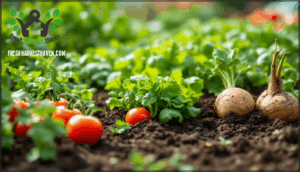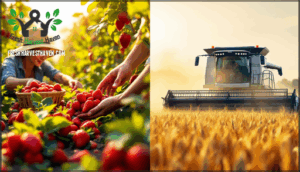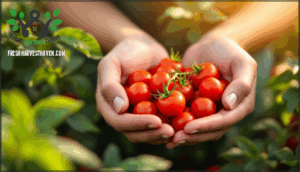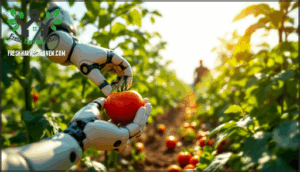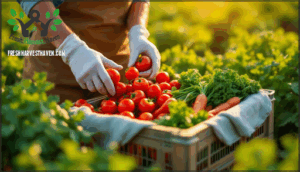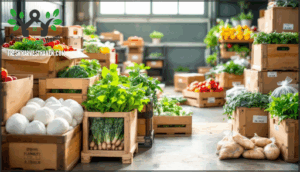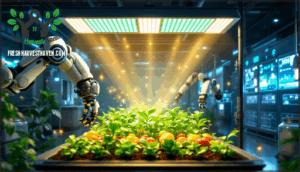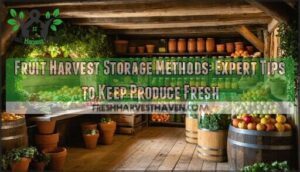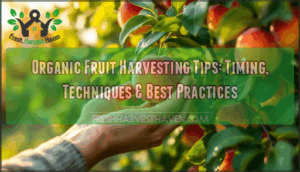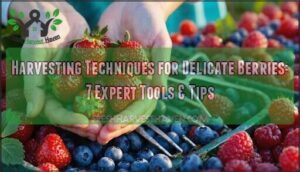This site is supported by our readers. We may earn a commission, at no cost to you, if you purchase through links.
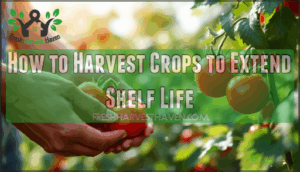
Your harvesting techniques directly control microbial growth, respiration rates, and physical damage that accelerate decay. From the precise moment you pick to the tools you use and how gently you treat each piece of produce, these decisions determine whether your crops reach consumers at peak quality or end up as waste.
Table Of Contents
Key Takeaways
- Harvesting at the right maturity stage—like picking fruits at one-third ripeness instead of fully ripe—can more than double shelf life from 3.4 to 7.8 days, making timing your most powerful tool against spoilage.
- Gentle handling cuts losses dramatically because bruising accelerates respiration rates five times over and makes produce 60% more vulnerable to decay, so using cushioned crates and limiting drop heights below 10 cm protects your profit margin.
- Rapid cooling immediately after harvest slashes respiration rates and ethylene production by 50%, extending shelf life 2-10 times longer when you combine it with proper refrigeration at 0-5°C and 90-95% humidity.
- Preventing mechanical damage and controlling ethylene exposure through storage separation and ventilation can reduce post-harvest losses by 25-50%, transforming waste into marketable product.
Key Factors Affecting Crop Shelf Life
You know that the moment you pick a crop, it starts a countdown. What you do during harvest—and the conditions surrounding it—can either extend that shelf life considerably or cut it short.
Let’s walk through the key factors that make the real difference in keeping your crops fresh longer. Here are the three main areas you need to focus on.
Crop Maturity and Optimal Harvest Timing
When you harvest at the right maturity stage, you’re playing the long game with shelf life. Fruits picked early stay fresher longer—one study found produce harvested at one-third maturity lasted 7.80 days versus just 3.40 days when fully ripe. That’s why timing matters.
Look for ripeness indicators like color change and firmness, not just guesswork. Wheat ready at 85–90% yellowing, tomatoes at full red—these signals tell you when to act. Optimal harvest is essential for maximizing crop yield and profitability.
Harvest too late and you lose quality fast. Get it right, and you’ll cut post-harvest loss, boost marketability, and win economically.
Environmental Conditions During Harvest
Weather shapes everything about your harvest window. Temperature extremes during picking directly impact how long your crops survive storage—harvesting when conditions are mild (18–25°C) keeps cells intact and extends shelf life by 20–30%, while heat waves trigger up to 15% more microbial decay. Humidity matters just as much. High moisture (>90%) invites fungal growth and 12% yield losses, while dry air below 60% causes rapid wilting. Rainfall adds another layer: excess moisture during harvest boosts fungal infections by 35% in grains and increases sprouting losses in onions by 20–25%. Optimal plant growth depends on humidity management.
Here’s what you’re managing:
- Temperature swings that accelerate ripening and spoilage rates in warm conditions
- Humidity imbalances causing either mold or water loss depending on extremes
- Rainfall and airborne pollutants that compromise product quality and safety
Your best move? Time your harvest for stable, moderate weather.
Handling and Mechanical Damage
But here’s where many operations stumble: rough treatment during harvest causes real damage to your bottom line. A single bruise accelerates respiration rates five times over, slashing shelf life dramatically. Impact forces above 0.5 newtons create internal bruising you won’t see at first—then decay hits fast.
Rough handling during harvest bruises crops, accelerating decay by five times and slashing shelf life before you even notice the damage
That’s why your care practices matter enormously. Cushioned crates cut bruising by 35%, while slower conveyor speeds reduce injury rates by 40%. Gentler handpicking works better than aggressive mechanical harvesters for delicate crops.
The cost? Bruised fruit loses 15–30% market value and spoils 40% faster due to elevated ethylene production and microbial invasion. Smart damage prevention isn’t optional—it’s your profit margin.
Optimal Timing for Harvesting Crops
Timing your harvest right is one of the biggest factors in keeping your crops fresh longer. Pick too early, and your produce won’t have developed the flavor and nutrients it needs. Wait too long, and you’ll lose quality fast.
The key is knowing exactly when each crop reaches its prime—and that depends on ripeness indicators, weather patterns, and what you’re actually growing.
Identifying Ripeness Indicators
Knowing when to pick your crop is half the battle in keeping it fresh. You can rely on several ripeness indicators to get it right.
Visual cues like color shift and firmness testing tell you plenty—mangoes drop from 44.54 N to 2.01 N as they soften. Sugar content and acidity levels matter too; sugar climbs while acidity falls as fruit matures.
For precision, spectral analysis and maturity indicators like chlorophyll degradation give you the data-driven signs of ripeness you need to harvest at peak quality.
Weather and Climate Considerations
Timing your harvest around weather patterns is key for shelf life. Heavy rain delays picking by raising field moisture, which accelerates microbial decay and compromises storage—you can lose up to 5.31% more produce in wet conditions. Temperature swings matter equally; cooler harvest windows extend dormancy and prevent spoilage, while warmer seasons shrink your storage window by 6–12% in temperature-sensitive fruits.
Smart farmers use weather forecasts to harvest before rain events, reducing spoilage by 20%, and monitor humidity to prevent disease. Here’s what to watch:
- Rainfall timing: Pick before heavy downpours to avoid moisture-related losses and mold growth
- Temperature stability: Cooler conditions during harvest preserve dormancy and dramatically extend shelf life
- Humidity levels: Low humidity during collection prevents foliar diseases, while post-harvest cooling at controlled humidity maintains quality
Timing for Different Fruits and Vegetables
Each crop demands its own harvest rhythm. Tomatoes hit their prime at the breaker stage—when just 10–30% of the surface shifts from green to red—giving you up to 21 days of storage life at cool temperatures. Apples need to reach their starch-iodine peak; pick too early and you’ll lose 70% more storage potential. Potatoes require skin set, a 10–14 day window after vines die down, to prevent bruising and rot. Grapes perform best at 22–24°Brix with proper acidity, storing 2–3 months when conditions align. Snap beans stay tender and fresh beyond 10 days when harvested at the pencil-thick stage.
Morning picking across all crops reduces water loss and extends shelf life considerably—you’re fighting the clock, so timing matters more than you’d think.
Harvesting Techniques to Reduce Spoilage
How you harvest matters just as much as when you harvest. The method you choose—whether hands-on or machine-driven—directly affects how long your crops stay fresh after picking.
Let’s explore the harvesting techniques that’ll help you minimize damage and keep spoilage at bay.
Manual Vs. Mechanical Harvesting Methods
Should you pick by hand or let machines do the work? The answer depends on what you’re growing. Manual harvesting wins for delicate crops—hand-picked strawberries show 25–30% less surface damage than mechanized methods, keeping them fresher longer.
But machinery transforms large-scale operations, processing ten times more area daily while cutting labor costs by 40–60%. Here’s the trade-off: machines risk bruising soft fruits, which speeds decay and shortens shelf life by up to 15%. Modern robotic advances with precision gripping are closing that gap, reducing damage by 25%.
For your operation, consider crop type, farm size, and quality standards. Delicate specialty crops favor manual techniques; broad-acre grains benefit from mechanization’s efficiency gains.
Gentle Handling to Prevent Bruising
Here’s the reality: bruised produce decays up to 60% faster than unblemished crops, cutting your shelf life in half. That’s why careful treatment isn’t just nice—it’s critical to your bottom line.
Your success starts with these proven strategies:
- Train your team rigorously — Personnel trained in careful protocols reduce bruise rates by 65%, dramatically lowering losses
- Keep harvest temperatures cool — Maintaining crops below 20°C reduces bruise severity by 15–25%, slowing deterioration
- Limit drop heights strictly — Restricting transfers to under 10 cm reduces fruit bruising by 75% versus standard practices
- Calibrate equipment regularly — Inconsistent equipment calibration increases bruises by 15–25%, so daily maintenance pays dividends
Bruising triggers rapid respiration and infection—bruised tissue becomes 5 to 10 times more vulnerable to decay organisms. Small impacts compound quickly. When you prevent bruising, you’re protecting your crops’ ability to stay fresh longer.
Specialized Tools for Sensitive Crops
What if the right tool could cut your harvest losses in half? Precision cutters and soft robotic grippers touch delicate crops without bruising—reducing spoilage by preventing the tissue damage that accelerates decay.
Ergonomic hand tools decrease operator fatigue by 25%, guaranteeing steadier use.
Mechanical harvesters with synchronized blade systems maintain deviation below 1 mm, preserving texture while sensor integration monitors ideal harvest conditions.
These specialized tools transform how you gather sensitive produce, extending shelf life measurably.
Post-Harvest Handling for Shelf Life Extension
You’ve harvested your crop at the perfect moment—now comes the critical next step. What happens in the hours and days after harvest will make the difference between produce that stays fresh and vibrant or spoils too quickly.
The key is understanding how to slow down the natural breakdown of your crops and protect them from damage during processing and storage.
Rapid Cooling and Refrigeration
When you harvest too late, your produce respires hard—burning through energy and nutrients faster than you’d want. That’s where rapid cooling changes the game. By dropping temperatures immediately after harvest, you can slash respiration rates by up to 50% compared to leaving crops at room temperature. This slowdown matters because it cuts ethylene production in half, which means your fruits and vegetables stay firmer and fresher longer.
You’ve got several cooling methods to choose from, each with its own strengths. Forced-air refrigeration works quickly on bulk crops, cutting cooling times to just 1–1.5 hours while keeping moisture loss minimal. Hydrocooling—dunking produce in chilled water—edges out forced air by 20–30%, making it ideal when speed is critical. For leafy greens, vacuum cooling is your best bet, reaching uniform temperatures in 30 minutes flat.
The real payoff? Proper cold chain integration can cut your postharvest losses by 25–50%. When you combine rapid cooling with controlled refrigeration at 0–5°C and 90–95% humidity, you’re looking at shelf life extensions of 2–10 times longer than ambient storage, depending on your crop. Modern systems with closed-loop controls even trim energy use by 15–25% per ton, so you’re saving money and product simultaneously.
Cleaning and Sorting Procedures
Once your crops are cooled, cleaning and sorting become your next line of defense against spoilage. Washing with sanitized water at 50–200 ppm chlorine cuts microbial contamination by up to 99%, dramatically lowering foodborne illness risk and decay. Proper cleaning removes soil harboring over 1 million bacteria per gram, while sorting identifies damaged produce that accelerates ripening.
Here’s what separates quality produce from waste:
- Microbial Reduction – Sanitized water washing decreases pathogen counts by 2 log units, reducing fungal contamination responsible for 16–36% of postharvest losses.
- Quality Assurance – Automated grading systems process 10,000 units hourly, improving consistency and cutting market rejection by 30%.
- Residue Removal – Rotary washers eliminate 97–99% of soil in one pass, extending shelf life 3–7 days longer.
- Sanitation Protocols – Daily tank sanitizing prevents 80% more bacterial buildup than irregular cleaning.
- Sorting Efficiency – Removing overripe items lowers storage losses by 25% while boosting shelf life overall.
Together, these postharvest practices can extend marketable life by 20–50%. You’re not just cleaning—you’re controlling decay at its source.
Minimizing Exposure to Ethylene
But here’s the thing—even spotless produce can spoil fast if you don’t control ethylene gas. This plant hormone triggers ripening and decay, especially in climacteric fruits like bananas and tomatoes. When ethylene levels spike above 1 ppm in storage, you can lose up to 50% of shelf life.
Your best move? Storage separation. Keep ethylene-producing fruits away from sensitive crops like broccoli and lettuce—mixed storage cuts marketable life by 40%. Add ventilation strategies to reduce ethylene buildup by 60%, or deploy ethylene absorbers using potassium permanganate to cut levels by 90%. Monitoring innovations with portable sensors let you catch problems fast. With these tactics, you’re controlling the ripening process itself, not just fighting decay after the fact.
Storage and Packaging Solutions
Once your crops leave the field, the right storage setup becomes your best tool for keeping them fresh longer. The way you package and store your harvest directly shapes how long it stays good, so getting this part right really matters.
Let’s explore the main strategies that protect your crops from the moment they’re packed until they reach your customers or table.
Modified Atmosphere Packaging (MAP)
Within your storage facility, modified atmosphere packaging (MAP) becomes your secret weapon for keeping produce fresh longer. This technology adjusts internal gas mixtures—primarily nitrogen, carbon dioxide, and oxygen—to dramatically slow spoilage. Here’s what makes MAP work:
- Reduces respiration rates in fruits and vegetables, cutting weight loss from 8.9% down to just 0.9–1.5% over 60 days
- Inhibits ethylene generation and microbial growth through controlled gas ratios, prolonging shelf life considerably
- Maintains color, firmness, and nutrient integrity across apples, lettuce, strawberries, and tomatoes
The MAP equipment market is booming—expanding from $2.4 billion in 2025 to $3.8 billion by 2035. That growth reflects real demand. Modern systems now incorporate smart sensors for automatic gas monitoring, while regulatory compliance standards (like EC Regulation 1333/2008) guarantee gas purity at 99%. You’ll find sustainability improvements too, with recyclable and fiber-based MAP films reducing plastic waste. Active packaging innovations using oxygen scavengers push performance even further, making MAP an investment in both shelf life extension and environmental responsibility.
Temperature and Humidity Control
But temperature and humidity don’t work solo—they’re a team. Cool your produce quickly to 0–5°C right after harvest, and pair it with humidity above 90%. This combination slows respiration and decay by up to 70%, meaning your crops stay fresher longer.
Here’s why it matters: tomatoes at 18°C lose twice as much moisture as those kept cooler, while even small temperature swings of ±2°C can cut nutritional retention by 25%. Modern cooling technologies maintain precise conditions within ±1°C, reducing post-harvest losses by 30%.
Humidity systems prevent wilting and shrinkage—especially critical for leafy greens needing 95–100% relative humidity. Energy-efficient refrigeration cuts greenhouse emissions by 20% while extending shelf life 2–4 weeks. Monitor both constantly to prevent spoilage and keep your inventory thriving.
Smart Packaging Technologies
Beyond temperature control, smart packaging transforms how you preserve crops. RFID tracking and IoT adoption monitor freshness in real-time throughout your supply chain. Sensor integration detects pathogens within 12–48 hours, alerting you before spoilage spreads.
Antimicrobial films and absorbent food trays work together—one fights bacteria, the other controls ethylene exposure. Modified atmosphere packaging regulates oxygen levels, slowing ripening dramatically.
These packaging improvements extend shelf life by up to 30 days while building consumer trust through visible safety features.
Technological Innovations in Shelf Life Extension
Technology is changing the way we harvest and store crops. From sensors that tell you exactly when to pick to smart packaging that keeps produce fresh longer, these innovations can seriously extend shelf life.
Here’s what’s making a difference today.
Precision Agriculture and Harvest Timing
You can think of precision agriculture as your crystal ball for harvest timing. IoT sensor integration and predictive yield models now help you pinpoint crop maturity with 85–90% accuracy, so you’re harvesting at peak ripeness.
AI harvest scheduling considers weather, soil conditions, and real-time data to cut losses by up to 20%.
VRT fertilization and robotic harvesting systems work together to boost your marketable yield while trimming costs—postharvest technology that pays for itself.
Automation and Sensor-based Monitoring
You’re stepping into harvest management’s next phase with automation and sensor-based monitoring. These technologies give you precision control through:
- Robotic harvesting with AI integration that achieves 95%+ real-time ripeness monitoring accuracy
- IoT sensors tracking moisture testing, weather data, and temperature monitoring for predictive analytics
- Smart storage systems that detect spoilage early and cut post-harvest losses by 20%
Automation doesn’t just save time—it protects your investment from field to warehouse.
Sustainable and Eco-friendly Harvesting Practices
Sustainable agriculture isn’t just a buzzword—it’s your bottom line and the planet’s future. Organic harvesting methods slash soil contamination by up to 50%, while regenerative practices boost soil organic matter by 20–40% in five years.
You’ll cut water waste by 60% with drip systems and reduce carbon emissions by 45% using electric machinery. Composting recycles 95% of crop residues, and biodiversity support through agroforestry increases pollinator density by 15–20%.
These low-carbon transport and waste reduction strategies improve quality and refine efficiency while minimizing environmental impact.
Frequently Asked Questions (FAQs)
How do pre-harvest treatments affect storage duration?
What steps can you take before harvest to make your crops last longer in storage? Pre-harvest sprays, irrigation strategies, and fertilization effects directly influence crop quality and storage duration by strengthening cell walls and reducing disease susceptibility.
What role does field sanitation play in reducing decay?
Field sanitation removes pathogen sources like plant debris and overripe fruit, reducing crop spoilage before harvest.
Combined with worker hygiene, equipment cleaning, and waste removal, these practices improve quality, reduce waste, and help prevent food loss throughout the growing season.
Can companion planting improve post-harvest quality?
Companion planting can improve post-harvest quality through plant interactions that reduce spoilage. Synergistic effects like natural biocontrol improve produce preservation and nutrition.
These methods complement proper storage conditions, extending shelf life by improving produce quality naturally.
How does irrigation scheduling impact crop longevity?
Irrigation timing directly affects water stress levels and root health, which influence nutrient uptake and post-harvest quality. Proper scheduling maintains ideal humidity control within plant tissues, reducing water loss and respiration rate after harvest, ultimately extending shelf life under proper storage conditions.
What are effective natural antimicrobial coating options?
Natural antimicrobials like chitosan applications, essential oil infusions, and plant-based coatings create edible films that extend shelf life.
These probiotic coatings and antimicrobial agents reduce food loss by protecting crops from spoilage organisms.
Conclusion
Here’s the reality: most produce waste isn’t inevitable—it’s preventable. When you apply the right harvesting techniques to extend shelf life, you’re not just picking crops; you’re engineering freshness from the field forward.
Every gentle touch, every cool morning harvest, and every quick shift to storage compounds into weeks of extra quality. Your harvest method is your first line of defense against spoilage, and now you know exactly how to use it.
- https://pmc.ncbi.nlm.nih.gov/articles/PMC10514919/
- https://www.tandfonline.com/doi/full/10.1080/87559129.2025.2544973
- https://www.ucdavis.edu/blog/researchers-examine-how-early-harvest-storage-affect-tomatoes
- https://onethird.io/one-third-blogs/9-methods-to-extend-the-shelf-life-of-fresh-produce
- https://news.mit.edu/2025/new-technology-extends-produce-shelf-life-0521

